Question
(10 points-suggested time 20 minutes)
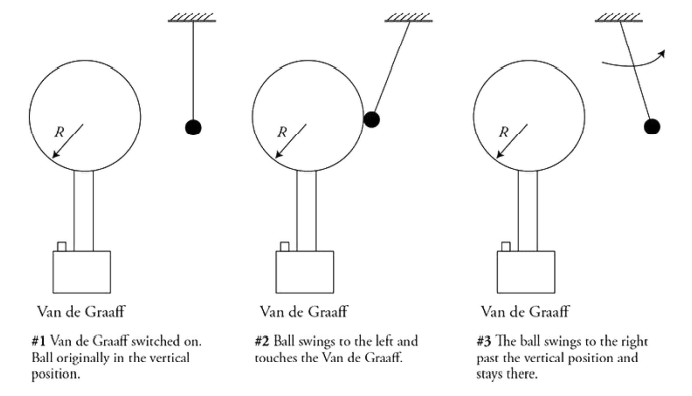
In a classroom demonstration, a small conducting ball is suspended vertically from a light thread near a neutral Van de Graaff generator as shown on the left of the figure. A grounding wire is attached to the ball and removed. Then the Van de Graaff generator is turned on, giving it a positive charge. After the Van de Graaff is turned on, the ball swings over toward, and touches, the Van de Graaff as shown in the middle diagram of the figure. After touching the Van de Graaff, the small ball swings away from the Van de Graaff toward the right and past the vertical position as shown in the figure at the right. The ball remains to the right of the vertical position.
(A) In a clear, coherent paragraph-length response, completely explain the entire sequence of events that cause the ball to behave as it does. Clearly indicate the behavior of subatomic particles and how any forces are generated.
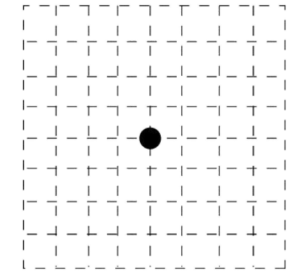
(B) The dot represents the small ball after it has swung away from the Van de Graaff when it is in its final position with an angle to the right of vertical. Draw a free-body diagram showing and labeling the forces (not components) exerted on the ball. Draw the relative lengths of all vectors to reflect the relative magnitudes of all the forces. (A grid is provided to assist you.)
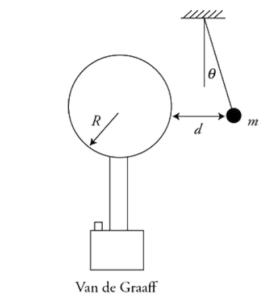
(C) In its final position the ball, mass m, is a distanced from the surface of the Van de Graaff generator and an angle θ from the vertical as shown in the figure. The Van de Graaff has a net charge of Q. Derive an expression for the magnitude of the net charge q of the small ball in its final position. Express your answer in terms of m, d, R, Q, θ, and any necessary constants.
▶️Answer/Explanation
Ans:
Part (A)
1 point-For indicating that the ball is originally neutral.
1 point-For explaining that the ball becomes polarized when the Van de Graaffbecomes positively charged. During polarization some electrons in the ball are attracted to the left of the ball. This causes a charge separation with the left side of the ball more negatively charged and the right side of the ball more positively charged.
1 point-For indicating that due to charge polarization the ball is attracted to the Van de Graaff. The negative side of the ball is attracted to the Van de Graaff with a greater electrostatic force than the electrostatic repulsion of the positive Van de Graaff and the positive side of the ball because of the difference in distances between the two sides of the ball and the charged Van de Graaff.
1 point-For explaining that when the ball contacts the sphere, the ball and the Van de Graaff become the same charge. Electrons move from the ball to the Van de Graaff leaving the ball with a net positive charge.
1 point-For indicating that the positive ball will now be repelled by an electrostatic force to the right and will no longer hang vertically.
Part (B)
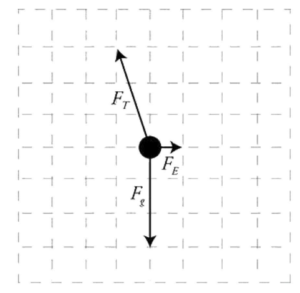
1 point-For drawing the electric force the same number of squares on the grid to the right of the ball as the tension force is drawn to the left of the ball.
1 point-For drawing the gravity force the same number of squares downward from the ball as the tension force is drawn upward from the ball.
Note: No points are awarded for incorrectly labeled forces. Deduct a point for each incorrect additional force vector drawn. The minimum score is zero.
Part (C)
1 point-For the correct expression of the electric force:
\(F_{E}=k\frac{qQ}{(R+d)^{2}}\)
1 point-For equating the horizontal component of the tension to the electric force and for equating the vertical component of the tension to the gravitational force.
There are two methods to do this:
Method#1
FE = FT sin θ
Fg = mg = FT cos θ
Method#2
\(tan \theta =\frac{F_{E}}{F_{G}}=\frac{F_{E}}{mg}\)
1 point-For the correct formula for the charge on the ball:
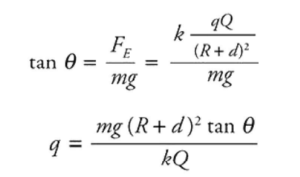
Question
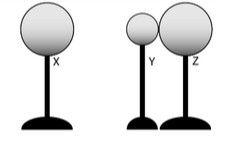
Three metal spheres rest on insulating stands as shown in the diagram at right. Sphere Y is smaller than Spheres X and Z, which are the same size. Spheres Y and Z are initially neutral, and Sphere X is charged positively. Spheres Y and Z are placed in contact near Sphere X, though Sphere X does not touch the other spheres.
(a) Does sphere Y have a positive, negative, or neutral charge? Explain.
(b) Does sphere Z have a positive, negative, or neutral charge? Explain.
Spheres Y and Z are now separated.
(c) Compare the magnitude of the charge on Spheres Y and Z.
Sphere Y is now moved so that it touches Sphere X.
(d) What happens to the magnitude of the charge on Sphere X? Explain.
▶️Answer/Explanation
Ans:
(a) Y has a negative charge. The force of attraction from Sphere X pulls electrons from Sphere Z into Sphere Y, giving it a net negative charge.
(b) Z has a positive charge. Z gives up excess electrons to Sphere Y, leaving it with a net positive charge. Spheres Y and Z are now separated.
(c) The magnitude of the charge on Spheres Y and Z is equal due to conservation of charge.
(d) The magnitude of the charge on Sphere X decreases due to a net flow of electrons from Y to X.
